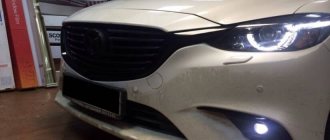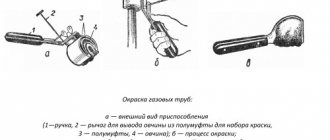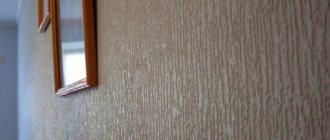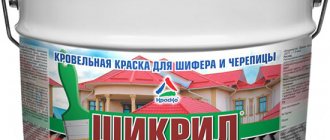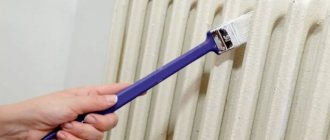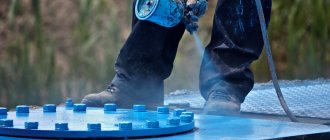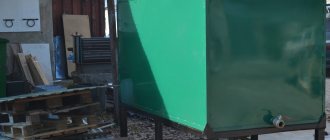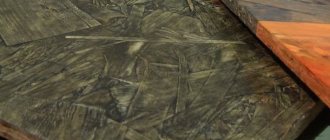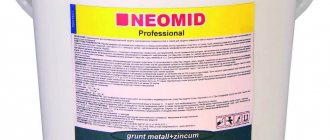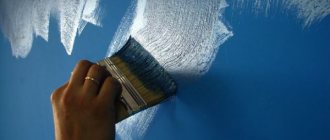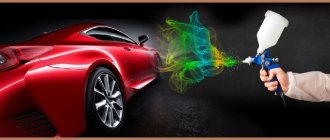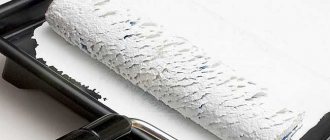There is an opinion that the galvanized surface of products does not need to be additionally protected by any means. But in fact, after time, products that have been galvanized inevitably need to be painted. And galvanized sheets used to cover the roof must be painted with protective paints for galvanizing, because the roof is subject to constant atmospheric influences. How to paint galvanized steel is described in the article.
What causes the need for coloring?
Experts recommend painting with special paints to ensure 2 main functions:
- protective, since the thin zinc layer gradually becomes thinner and becomes unable to withstand negative natural influences;
- A decorative, varied color palette, instead of the original gray color, will give the metal structures and the entire building an original and attractive appearance.
Based on the results of numerous experiments, it was concluded that it is best to paint galvanized iron after a year, during which time the galvanized sheets will “age” naturally, the surface will acquire a roughness that improves adhesion when applying paint. If it is necessary to carry out painting at an earlier date, the surface of the sheets is treated with abrasives.
Why paint galvanized iron
Galvanized metal does not rot or rust under the influence of the environment.
Galvanized metal does not rot or rust under the influence of the environment. Therefore, at first glance, there is no reason to paint this material. But if we consider the real situation, then everything is somewhat more complicated.
Zinc is one of the rather soft metals, so scratches may appear during transportation or installation, the depth of which reaches 0.1 mm. A galvanized roof does not withstand the abrasive effects of wind due to dust and fine sand. As a result of prolonged exposure to galvanized metal, stripes may appear on it without protection. Most often this is observed in the area of the ridge, roof overhangs or eaves.
If the roof is not painted on time, a white coating may soon begin to form and after that the corrosion process will be quite problematic to stop.
It is worth noting that after the zinc layer is erased from the metal, corrosion begins to penetrate under the protection itself. Because of this, the damaged area may be much larger than it appears at first glance.
What is galvanized steel
Galvanized steel is steel that has been galvanized, that is, a thin layer of another metal material has been applied to it through production. This reduces the electrode potential of zinc. This process helps to obtain additional properties from the material:
- Mechanical protection from environmental factors;
- Electrochemical. Thanks to the treatment, damage to the zinc layer does not lead to the harmful effects of corrosive formations.
Thanks to the treatment, damage to the zinc layer does not lead to the harmful effects of corrosive formations.
What requirements must paint compositions meet?
When selecting paints, it is necessary to take into account the presence of the following mandatory properties:
- providing long-lasting protection from negative atmospheric factors;
- galvanized paint should not fade under sunlight;
- possessing high elasticity and adhesion;
- good hydrophobicity, providing resistance to moisture in the form of rain and snow;
- sufficient frost resistance and resistance to temperature changes when used for outdoor work;
- quick drying;
- ease of application;
- harmless to human health and the environment;
- attractive appearance.
All about modern decorative plasters
Modern decorative plasters are an excellent choice of paints and varnishes for renovation and construction of a house or apartment. Their use makes it possible to improve the appearance of structures, hide and eliminate visible defects, improve the indoor microclimate, and facilitate subsequent work. The main thing for today is to understand all the diversity presented in order to get the ideal final result. More details
Types of paints
Painting galvanized steel, which has a high degree of passivity, is recommended to significantly increase the service life. When choosing how to paint galvanized steel so that the paint does not peel off, the mandatory presence of elastic characteristics and good adhesion quality are taken into account.
Not all paints and varnishes will be able to cope with the task. For this purpose, alkyd, acrylic, rubber, and vinyl enamels can be considered.
Painting galvanized steel, which has a high degree of passivity, is recommended to significantly increase the service life.
Acrylic
The first in the rating of products for painting galvanized steel is the acrylic type of paint. They create reliable protection and contain anti-corrosion substances as components. The following advantages are also noted:
- Resistant to temperature changes and ultraviolet radiation;
- Duration of operation;
- Moisture resistant property;
- High degree of adhesion;
- Good value for money.
Acrylic paints provide reliable protection; their components include anti-corrosion substances.
Alkyd
This type creates good protection. A glossy finish is created on the surface. They contain elements that help avoid corrosion on the material. It should be noted that the constituent components react with zinc, and as a result its structure changes in a negative direction.
Regularly chosen for painting near the ocean and sea.
This type creates good protection.
Vinyl enamels
Vinyl paints may be the best option for this material. According to a number of indicators, the vinyl type copes better than other enamels in protecting the material. They are distinguished by high rates of creating a barrier from surrounding factors.
They are distinguished by high rates of creating a barrier from surrounding factors.
Special coloring compounds
Painting galvanized sheets should optimally be done with special paints, which were developed for this purpose. You can use acrylic primers, which perform two functions - protection and creation of a beautiful coating. The cost is higher, but the resulting properties easily justify it. Some people choose paints with rubber crumbs, which also create a reliable coating for the material.
Painting galvanized sheets should optimally be done with special paints, which were developed for this purpose.
Imported paints
Among foreign products for painting galvanized steel with your own hands, buyers also highlight Tikkurila. “Hammerite” can be applied to metal that has already been corroded without prior preparation. However, over time, if there is corrosion, the layer will peel off, so it is better to clean this area in advance. The quality of foreign paints is good, but the price is higher than Russian ones.
The quality of foreign paints is good, but the price is higher than Russian ones.
Domestic products
Among Russian products, a special place is occupied by Tsikrol paint, which is distinguished by its high quality. This is a specialized product for painting galvanized steel. In addition to good performance characteristics, the possibility of painting without a priming step is noted.
Among Russian products, a special place is occupied by Tsikrol paint, which is distinguished by its high quality.
Rubber coloring compound
On sale you can find special rubber solutions that can be used to paint galvanized iron. They tolerate even prolonged exposure to moisture very well and can be used in different weather conditions. In addition, such compositions are completely safe for human health and are among environmentally friendly materials.
We recommend: How to make a smokehouse with your own hands
Is soil needed or not?
Rostex Super primer
When choosing a specific paint, you should pay attention to the manufacturer’s recommendations for preliminary surface preparation. The fact is that some people advise painting only primed substrates. For example, alkyd paint Panssarimaali (Tikkurila) is applied to metal roofing, drainpipes and gutters and other metal structures only after they have been treated with anti-corrosion primer Rostex Super (Tikkurila). This is exactly what experts suggest to do. To enhance the adhesion of the paint coating to the metal, they recommend using anti-corrosion phosphate primer for ferrous and non-ferrous metals “Phosphogrunt” under the “Tsikrol” paint.
Other manufacturers allow paint compounds to be applied to metal roofing without prior priming. Among them, “Enamel for galvanization and rust Oreol” (“Empils”). It combines the properties of an anti-corrosion primer and protective and decorative glossy enamel, having high adhesion to galvanized surfaces (clean, rusty or previously painted). Kirjo Aqua (Teknos) alkyd roofing paint does not require primer.
Renewal of paint and varnish coatings is usually carried out every 8-10 years. Old paint must be removed. Otherwise, the new composition will not adhere well to the surface and will quickly peel off.
How to distinguish stainless steel from galvanized
Both materials are often used to construct coatings that are not susceptible to corrosion. Stainless steel has longer anti-corrosion properties, durability of up to 50 years and is more expensive, so unscrupulous sellers can slip galvanized steel to the buyer under its guise. After all, high-quality stainless steel is practically indistinguishable in appearance from galvanized steel.
The main differences visible upon external examination:
- if the sheets are thick enough, you can notice the heterogeneity of the galvanized product in the sections;
- The galvanized sheet may have individual characteristic spots, called crystallization patterns. In the absence of such spots, the surface is mirror-like with a slight bluish tint. The surface of stainless steel is more matte;
- magnets are not attracted to most stainless steels;
- zinc actively interacts with hydrochloric acid, therefore, when a drop of acid gets on the galvanized surface, swelling is observed with the gradual dissolution of zinc;
- galvanized steel is easily scratched by a nail.
The most accurate determination of the type of material can only be carried out by spectral analysis, but this requires the availability of appropriate equipment and instruments, as well as time costs.
The last method is to select suppliers from well-known companies that have been working in the sales market for a long time, and legally competent registration of the purchase with the provision of quality certificates.
- Roof
- Exterior finishing
Galvanized iron - what is it?
Galvanized iron is considered universal; it consists of roofing steel sheets of different shapes and thicknesses. After the appearance of more innovative materials, it temporarily lost its popularity, but individual construction returned it to the market due to reliability and reasonable pricing.
Galvanizing is carried out to protect the metal from rust and corrosion. Galvanized sheets are used to cover the roof, install a fence made of corrugated sheets, zinc is used for pipes, etc. One can highlight the advantages that galvanization is particularly resistant to negative weather conditions, it is easy to work with, and when painted it has a pleasant appearance.
Galvanized iron is considered universal; it consists of roofing steel sheets of different shapes and thicknesses.
How to distinguish stainless steel from galvanized
Stainless steel differs from galvanized iron, first of all, in the time interval, that is, in how long the material can resist the formation of corrosion. Stainless steel is much more expensive than galvanized steel, but dishonest sellers can sell galvanized steel under the guise of stainless steel. In order not to encounter such deception, you need to know a number of ways to distinguish these two materials.
The most reliable method is to conduct spectral analysis. But it is not always convenient to carry out, and you will have to wait until the results are ready. Therefore, there are less accurate, but easier methods. The first option is to evaluate the product externally; there are spots on the galvanization that are called “crystallization patterns.” Stainless steel has a greater dullness than a galvanized surface, of course, unless mirror processing has been carried out.
If the stainless steel has been processed according to the VA standard, it will be almost impossible to distinguish it from galvanization by external factors. If the sheet is thick, you can look at the cut line to see if it is uniform.
You can take a magnet with you, because stainless steel material is not magnetic, but galvanized material, on the contrary, is magnetic. You can also use hydrochloric acid. The fact is that when the acid comes into contact with galvanization, a chemical process will occur: bubbles will appear and the zinc layer will begin to dissolve. Well, you can buy galvanized steel from an honest seller who will not let you down.
There are spots on galvanized steel that are called “crystallization patterns.”
What causes the need for coloring?
The zinc layer serves to protect steel elements from the negative influence of the environment; it reliably protects the surface. But after a certain period of time, it will lose its positive properties, and “white rust” will appear on the steel, which will begin the process of destruction. Therefore, it is necessary to use paint on galvanized metal for exterior work; such a coating will protect the product and increase the service life of the product.
In addition, galvanizing paint will make the painted product more beautiful. Painting galvanized metal will require an investment of money, but it is a more economical option compared to replacing a damaged product.
Practice has shown that it is better to paint galvanized products a year after the start of operation, the zinc will begin to peel off and the surface will become rough, which will make the surface more ready for adhesion to the painting composition. If painting is required earlier, abrasive agents are used.
This coating will protect the product and increase the service life of the product.
Polyurethane paints for galvanized roofs
Coatings based on polymer urethane resins are considered more resistant to external loads. Experts recommend using polyurethane paint and varnish compositions in cases where there is a huge amount of sand, ice and other materials on the roof that have an abrasive effect on the galvanized coating.
Polyurethane and alkyl-urethane paints perfectly preserve the color scheme; it is believed that it is best to paint old and fairly worn roofs with such materials. For example, inexpensive “Unikom” adheres perfectly and is held on to a metal roof that has been worn to holes, even if areas and traces of galvanized coating remain on the surface. Whereas, before using the most popular acrylic composition “Tsikrol”, it is best to first paint the roof with a primer that improves adhesion to zinc.
Epoxy resin based paints and varnishes
Epoxy resins are used to make a huge number of materials for various applications. They are used in the radio electronics, electrical engineering, shipbuilding, aircraft and mechanical engineering industries, including as film-forming paints and varnishes, as components of impregnating and casting compounds, sealants, adhesives, etc. A wide selection of film formers allows you to create products with a wide variety of properties (for example, EP-741 varnish, HP-0064 putty). These compounds are used for anti-corrosion protection of products made of wood, concrete, plastics, metal structures and others. About 50% of the total world production of epoxy resins is used for these purposes. More details
Paint requirements
When choosing paint for painting galvanized iron, it is necessary that the composition has certain properties.
- Protected for a long time from exposure to moisture and precipitation.
- The paint should not lose its color when exposed to sunlight.
- The material must have a high rate of adhesion and elasticity.
- The composition must have excellent hydrophobicity, so galvanized iron can withstand exposure to precipitation well.
- Can be used for outdoor work, because it tolerates temperature changes well.
- Has an attractive appearance.
Requirements for coloring compositions
Not every paint is suitable for a smooth finish. It must have maximum adhesion, that is, ideally adhere to the surface. Since galvanizing, although to a lesser extent, is also susceptible to corrosion (as evidenced by the appearance of whitish spots on it), it is desirable that the paint contains anti-corrosion components.
Traditional alkyd compositions based on resins that can react with zinc, as well as oil paints, are not suitable for these purposes. They contain not only acids and alkalis, but also some additives that can destroy the galvanized surface. Therefore, paint and varnish materials used for painting must be neutral to zinc.
Paint on galvanized metal intended for exterior use must be frost- and chemical-resistant and resistant to UV rays. Particular attention must be paid to its elasticity - after all, zinc changes dimensions when the temperature changes. Regular paint will crack and peel during use. Naturally, the color should also be selected so that it matches the exterior of the other buildings.
How to paint galvanized metal
For a quality result, it is important not only to choose the right paint, but also to know how to paint. First of all, the preparatory work is carried out:
• remove old paint; • remove dirt; • the surface is washed; • degrease; • dried; • repair defects.
Then you need to paint the galvanized metal. Paint on galvanized iron is applied with brushes, rollers or spray guns. Acrylic primer enamels can be applied in 2-3 layers. Efficiency can be increased by using several primer compositions.
First, before painting, apply the first composition, then after complete drying the second. The primer is applied with a lint roller. Then a primer with anti-corrosion characteristics is applied. After this, you can apply primer-enamel.
Tips for painting metal and choosing paint (2 videos)
Products of different brands (35 photos)
Deciding on the dye
How to paint galvanized steel must be decided at the beginning of the work or even at the planning stage, since not every coloring composition may be suitable for the surface. Standard painting of galvanized elements is quite primitive, and therefore, in order for galvanized products to be combined with the overall interior of the building, they are additionally painted in the desired color.
The main purpose of zinc coating is to decorate and protect steel surfaces, elements and structures from negative external factors.
Nuances when working with galvanized surfaces
When planning to work with elements made of galvanized steel, the following points should be considered:
- You should choose a material that contains not only special additives to increase grip on the steel surface, but also anti-corrosion elements
- Galvanized products cannot be treated with paint and varnish compositions that contain chemicals that contribute to the destruction of zinc, for example, various anti-corrosion additives, acids, solvents and alkalis;
- For structures operated in harsh aggressive environments, it is necessary to use specialized compositions - electrically conductive and fire-resistant paints for metal products;
- Galvanized coatings have a smoother surface compared to untreated surfaces of the material, and therefore adhesion to other materials will be lower. Based on this, before painting galvanized steel, you should carefully prepare the working surface, increasing the adhesion of zinc to the new paint and varnish composition;
- It is also important to pay attention to the degree of elasticity of the material, since a coating with poor elasticity will simply crack and delaminate on a metal surface, which is characterized by slight changes in shape when heated and cooled. All this will lead to the fact that the composition will simply completely “peel off” from the steel surface over time.
We recommend: Polyurethane self-leveling floors, their advantages and purpose
Important point! Paint for zinc should not negatively affect the characteristics of steel; it must have good adhesion, high elasticity and resistance to external negative factors.
Choosing a Zinc Coating
Steel surfaces can be treated with various colorants:
- Polymer paints, which can vary greatly in their characteristics. Today, ground enamels, as well as latex and polymer compositions, are distinguished. In practice, despite the high cost, ground enamels have proven themselves to be excellent;
- Alkyd compounds that perfectly protect metal surfaces. In addition, they stand out for their considerable service life and a wide range of colors;
- However, alkyd paints are not recommended for use as a protective agent for galvanized products due to the fact that the paint contains aggressive components that can affect the surfaces of steel elements!
- Oil paints. The characteristics of the coloring composition allow it to create a film on the treated coating that does not allow water to pass through. Thanks to this, the galvanized product becomes well protected from the effects of snow and rain. At the same time, such paints have good adhesion to steel. However, oil-based paints also contain substances that can react with zinc, causing its destruction. Based on this, it is not recommended to use such products for painting galvanized steel.
- When choosing a paint composition to protect steel elements, it is better to give preference to acrylic primer enamels containing neutral substances that cannot have any negative effect on steel!
The cost of paint can vary greatly. By and large, the price will depend on the manufacturer and the volume of the can. When purchasing, you should choose products from a trusted manufacturer. If you plan to do the painting work yourself, the final cost will be lower!
Galvanizing paint Tsikrol 2sh
Paint for galvanized metal surfaces Tsikrol 2sh is a semi-gloss elastic polyurethane paint with increased adhesion to galvanization. Contains substances that slow down corrosion.
Zincroll 2sh is used to protect galvanized roofs, the surface of gutters, awnings and other similar surfaces. The paint has excellent decorative properties and high mechanical strength. Perfectly protects the surface from the effects of chemical compounds and aggressive atmospheric influences, even in marine or tropical climates.
The paint can be applied both to a cleaned surface and to a surface with traces of corrosion damage. Zincroll 2sh allows you to protect galvanized surfaces from destruction in temperate and cold climates for 12 years , and in tropical and marine climates for up to 7 years !
Paint for galvanizing - on the website krasko.ru
.
You can find out more detailed information about painting galvanized roofing (galvanized roofing, painting galvanized sheets, how to paint galvanized sheets) on the website pages.
Painting technology
In order for painting metal with your own hands to bring the desired result, you should carefully study the instructions on the container with paintwork materials and strictly adhere to them, then the treated surface will be able to maintain a good appearance for a long time.
Tools and equipment
For the classic method of painting metal, you need to prepare:
- roller, brushes of different widths;
- paint container;
- the coloring composition must be shaded;
- primer for metal.
Additionally, you will need masking tape and plastic film.
Application methods
To apply paint you can use:
- Paint brush. Suitable for painting small parts. You can find brushes of different sizes on sale. The bristles can be natural or synthetic. For access to hard-to-reach places, the tool is equipped with an elongated curved handle.
- Roller. Suitable for painting large flat surfaces.
- Sprayers. The second name for the spray gun. A compressor is used to operate them. The coloring composition is supplied under pressure. The equipment is used by large enterprises, car repair shops, carpentry, and blacksmith shops.
- Containers for dipping metal workpieces. This method makes it easy to paint parts with complex shapes.
Modern technology - powder coating of metal. The blanks are placed in a closed spray booth and covered with a layer of paint. Its particles receive a negative electrical charge and are attracted to the working surface, creating a dense, uniform layer. After applying the powder, the workpiece is placed in an oven so that the decorative layer bakes and becomes monolithic.
Preparing for painting
Before you begin painting galvanized metal, the surface to be treated should be well prepared. And, in particular, carry out work that increases the adhesion of the zinc coating.
In order for the paint composition to lie evenly and tightly on the galvanized surface, it must be absorbed and penetrate its natural microdeformations. If there are few of them, or they are practically absent, they should be created artificially. Often, for this purpose, the surface to be treated is coated with an abrasive substance.
There is another good way - if the galvanized surface (in particular, the roof) has been in contact with air for a long time - half the job is already done, since in one year fresh zinc, or rather its surface, has time to react with oxygen, while coated with a layer of oxide, which absorbs paint remarkably well. But nevertheless, even such zinc should be slightly cleaned and degreased with a solvent.
When choosing any materials for painting a roof or other galvanized surfaces, it is best to pay attention to abrasives, primers, paints and solvents from the same company, since the chemical components in them are specially selected for joint use.
Creating a protective layer on the surface
If the zinc surface has previously been coated with a layer of paint, it should be cleaned of any remnants of these materials. To do this, it is best to use a solvent and a metal brush. This work should be carried out carefully, since it is not at all advisable to remove the zinc layer along with the paint layer from the roof.
After this, again, you need to clean the surface of any remaining dirt that has formed. You can use an alkaline detergent for this.
Painting galvanized metal
Immediately before application, the coloring matter should be thoroughly mixed and poured into a special tray. It is best to apply a thin layer of paint with a roller, brush or spray. Before applying a new layer, you should wait until the previous one has dried.
It is optimal to paint in two layers. But to achieve maximum results, when the paint color will sparkle with more saturated shades, and the coating itself will have strong protective properties, you can apply three layers of paint and varnish material.
What is better to use for a wooden house: tow, moss or sealant?
What is better to use for a wooden house or bathhouse: tow, moss or sealant?
This question faces everyone who builds their own wooden house. It doesn’t matter what is used to create a log house - logs or beams, there will still be gaps between them. These are the ones you should get rid of first. For these purposes, in our country it has traditionally been customary to use natural materials moss and tow. But today a new product has appeared - sealant. It is also used for insulating seams between logs and for sealing chips and cracks on wooden surfaces. More details ↑ Up
The SpetsEmal company supplies paints and varnishes for special purposes: oil-gasoline-resistant, heat-resistant, auto enamels, fire protection and many others. Please note that we also sell fire retardant materials for metal, wood, concrete, plastic, textiles. A wide selection of coatings on different bases: AK, AS, VL, FL, HP, EP, GF, KO, HS guarantees satisfaction of your needs! Special prices apply: primer bep-0237, varnish ep-730, varnish pf-170, paint ko-42t, enamel pf-1315.
PREPARING THE SURFACE FOR PAINTING
In the question “how to paint galvanized steel so that the paint does not peel off,” you should adhere to certain recommendations for preparing the surface of galvanized steel:
Removing old paint using the stripping method
For these purposes, sandpaper or sandblasting is used. Cleaning is done so that the old coating is removed, but the base is not damaged.
Treatment with a degreasing compound
Degreasers allow you to remove dirt, grease, mold and other deposits from the surface that can impair the quality of the paint. At the same time, the degreasing composition does not damage the surface of the product itself. It is recommended to carry out treatment in small areas to prevent problem areas from being missed.
We recommend: How to install a ceiling cornice
For cleaning and degreasing, the following are most often used:
- White Spirit;
- Chlorine bleaches;
- Comet;
- Kerosene.
Drying
It is carried out until the surface is completely dry to prevent the degreaser from reacting with further applied products.
Removing white rust
White rust occurs as a result of the destruction of the galvanized layer under the influence of the environment and is a white powdery film. White rust can be removed using fine-grit sandpaper with a grit rating of 120 or less. Sanding is done with light circular movements. At the end of the process, the dust is removed with a slightly damp cloth or rags.
Abrasive treatment
To improve the adhesive properties, allowing the paint to adhere as firmly as possible to the surface being painted, the steel must be treated with abrasives and white (distilled) vinegar. The acid contained in vinegar will etch the galvanizing and give it a rougher structure; substances containing abrasive particles will help enhance the effect.
Exposure to vinegar is usually a minimum of 1-2 hours. It is worth considering that the longer the acid acts on the surface, the more pronounced the etching effect.
Padding
Most often, latex and epoxy primers for exterior use are used for these purposes. It is worth considering that due to its durability and resistance to damage, epoxy primer is optimal in cases where the product will be in the most aggressive conditions. The composition is applied with a brush or spray. The latter is most appropriate if we are talking about a large cultivated area. Application is carried out in a sectional manner, allowing for the most accurate distribution of the primer. Exposure time depends on the brand of primer mixture used and averages from 2 to 6 hours. You can start painting only after the primer has completely dried and there is no sticky effect.
Is it necessary to paint galvanized metal?
Galvanized steel is protected effectively, but the zinc layer is quite thin - the thickness is about 0.8-2 microns. Over time, under aggressive influences, the zinc itself begins to corrode. So-called “white rust” appears on the surface - a white powder. This rust has an unaesthetic appearance, and the surface of the steel is not protected in any way and is more exposed to adverse effects.
Galvanized metal is often used for roofing as well as other construction work, so it is necessary to paint the surface to protect the steel from corrosion.
Advantages and disadvantages of the method
The pros and cons of painting metal depend on the type of paint composition used. Advantages of painting metal surfaces, provided the technology is followed:
- Getting the required shade. You can find different colors on sale.
- Availability of consumables.
- Easy to apply paint using a brush or roller.
- Protection against rust formation.
Flaws:
- Many types of coloring compounds emit a persistent, unpleasant odor. The room needs to be ventilated for a long time.
- For powder coating you will need special equipment, a spray booth.
- Not all types of paint protect metal from corrosion.
Most of the shortcomings can be leveled out if you buy a high-quality coloring composition and carry out the work strictly following the technology.
Waterproofing foundations and roofs
Proper waterproofing of the foundation and roof is extremely necessary as one of the stages of building a house or bathhouse. Already during the laying of the building, work should be carefully carried out on the foundation. Creating an insufficient or poor-quality water-repellent layer on it can subsequently lead to serious damage to the entire structure as a whole. More details
How not to paint galvanized steel
Protective coated roofing material should not be painted with paint compounds containing high acid salts or alkaline soaps, commonly used in paints to promote adhesion and convert rust to iron phosphate. Unlike steel, the zinc layer quickly dissolves with the formation of amphoteric compounds, as a result of which the paint peels off and comes off the roof surface along with the galvanized coating.
The second limitation is the presence in the paint of special toners or pigments based on powdered copper, tin or antimony. If you paint galvanized paint with copper pimento paint, even in oxidized form, the process of degradation of the roofing coating still occurs, although at a noticeably lower rate than with direct contact with copper.
Fire protection for your wooden house and bathhouse
Wooden houses, baths, saunas are places with high humidity and fire danger. Their surfaces require additional treatment with protective compounds: fire retardants, antiseptics and special varnishes/primers. Competent fire and bioprotection of a wooden house and bathhouse allows... Read more
Protective equipment and precautions
We should not forget that toxic and flammable substances are used in the work, for this reason it is necessary to prevent any possibility of contact of paint with open fire. Smoking is strictly prohibited in the area. If work is carried out indoors, care must be taken to ensure that it is properly ventilated during and after work.
If you have a large volume of such work on a large area of the surface to be painted, get respirators to protect your respiratory tract. Do not forget to use special clothing, gloves and comfortable shoes.
- How to use
- Construction paints
- Working with paints
Features of painting a galvanized roof
There are several ways to paint a galvanized iron roof; the tools and painting techniques are practically no different from those used to apply paint to a regular metal surface, for example, when painting a metal gate or a black steel fence.
But zinc is an unusual metal; its structure is such that, regardless of the method of application to thin sheet steel, the galvanized surface is formed from a huge number of microcrystals. If you touch the galvanized surface with your fingers, the thin zinc film will seem slightly greasy, as if a small amount of silicone grease had been applied to it.
Sometimes would-be craftsmen, before painting a galvanized roof, treat the metal with a solvent, just as is done when applying paint to ordinary black steel. As a result, the paint lies unevenly on the roof surface, often even rolling off in microdrops.
Therefore, before painting galvanized iron on a roof, you will need, at a minimum, to properly prepare the surface and carry out a treatment that increases the adhesion and stability of the paint base.
No need to rush
Experts do not recommend painting galvanized roofing immediately after installation. During production, metal sheets are coated with mineral oil to protect their surface from mechanical damage and exposure to water during transportation and storage. Of course, the oil film can be removed using organic solvents. But why waste time and effort if in one or two years it will disappear on its own from various precipitations, without any outside intervention. Galvanized surfaces that have become matte as a result of mechanical sanding or weathering have the best adhesion to the paint coating.
During the period of work, the roof should not heat above 40°C. Otherwise, the solvent included in the paint will dry too quickly, not providing the necessary adhesion of the layer to the base.
Tips and tricks
Maximum surface quality can only be achieved in calm weather, so the best time to paint the roof is a quiet autumn morning. Cleaning and preparing the roof surface can be done the evening before the work.
The second layer is applied to the metal in the evening, after thoroughly drying the surface. During this time, it is important to inspect the applied first layer and identify flaws and places that require touch-up.
The last pass is to tint the details of the drainage system and the ridge.
